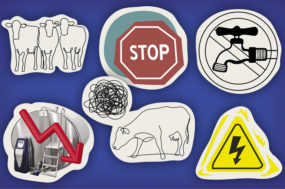The media often likes to simplify their reporting on the trade deals with agriculture examples. However, neither the CETA negotiations nor the TPP addresses the issue of agriculture subsidies.
They do, however, take aim at tariffs, which are important for supply management here in Canada. The reality is that it has always been possible to exclude, exempt or introduce favourable treatment for the more sensitive issues or sectors in the many trade agreements negotiated on a bilateral, plurilateral or multilateral basis.
As I write these lines, there are negotiations going on with both Europe and TPP, and both aim to finish in 2013: CETA in April and TPP in the fall, although Japan joining the TPP is likely to push this timeframe further in the future.
TPP
Some background on the TPP talks: They officially started in March 2010 and build on an existing trade agreement between four countries: New Zealand, Brunei, Chile and Singapore.
There are currently 11 countries in the TPP, Canada and Mexico having joined in 2012. Canadian negotiators have now participated to two rounds, one in New Zealand and the other in Singapore, March 4 to 14.
Japan and Thailand are expected to be invited, despite the targeted completion date being October 2013.
While the Canadian media has said that supply management is one such sensitive issue, a November 2012 study by Grey Clark and Shih, “The Trans-Pacific Partnership: NAFTA 2.0 or Doha Revisited?” points out a number of these sensibilities from various TPP countries which make negotiations difficult.
The U.S. wants to protect sugar, their dairy from New Zealand and a number of other dispositions related to transportation while being aggressive on protection of intellectual property. New Zealand is sensitive to its pharmaceutical program and their kiwi marketing board.
Australia does not like the U.S. approach to investor state dispute settlement or e-commerce. Malaysia and Taiwan don’t appreciate restrictions on rules of origin, etc. This long list leads trade expert Peter Clark to conclude that, in TPP, “a balance of exceptions must be found.”
It remains that the entry of Canada into TPP could be a challenge for Canadian dairy as a number of partners, including New Zealand, Australia and the U.S., have indicated they want more access to the Canadian dairy market.
It is interesting that dairy stakeholders in the U.S. are asking their negotiators to insist on more access to Canada for a full range of dairy products as well as commercial shipment of fluid milk. At the same time, they remain opposed to the expansion of imports from New Zealand.
CETA
On CETA, Canada remains offensive in pursuing more access for beef and pork, though for hormone-free beef and pork that does not use a specific antibiotic which the EU frowns upon.
Europe is always looking for more markets where it can sell its cheese; Europe actually exports more cheese (more than 680,000 tonnes) than Canada produces.
They also firmly insist on geographical indications for many food products, including several cheeses we produce here.
This could potentially mean Canadian cheese makers could no longer call their product “feta,” for example. Canada, like the U.S. and several other countries, consider these cheese names as “common,” which should not be protected to allow only cheese makers in Europe to produce.
Where do we go from here?
Dairy Farmers of Canada (DFC) supports the government’s balanced trade position and we also maintain the same position on trade with EU, TPP or WTO – that trade should not negatively affect our dairy industry.
As such, we continue to oppose any potential reduction in over-quota tariffs or increased access. Canada’s market access for cheese is 10 to 15 times greater than the access offered by the Europeans in their significantly bigger market.
The Canadian government’s support for supply management has remained firm because of the economic viability of the industry, the fact that dairy farmers pursue practices that are sustainable on the social and environmental fronts as well as innovative in taking care of animals. The dairy industry is one of the top two agricultural sectors in seven out of 10 provinces.
We do, however, need to continue driving change within our supply management system. DFC has said for many years that the Canadian market for dairy products is national in nature. The merger of Agropur with Farmers’ Dairy in the Maritimes is just one other example.
The market for dairy products is also changing as the population changes, matures and becomes more diverse on the cultural front. Today’s society, in the U.S. or Canada, is more removed from the farm.
Consumers have a number of expectations that may not always be easy to understand, but deep down, farmers and consumers share a number of similar values: they want to access (or provide) quality products, know that animals are well treated, the environment is cared for and where their food comes from.
This presents challenges but also opportunities which are ours to take advantage of. The proposed proAction Initiative is a means of developing programs by producers and for producers that respond to consumer demands.
While responding to changing markets is not always easy, it is necessary to remain responsive and maintain the support of governments and the public. PD
 |
|
|
Richard Doyle |








